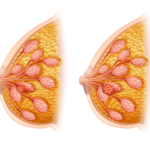Prophylactic (Preventive) Mastectomy
A prophylactic mastectomy is a surgery to remove one or both breasts to lower the chances of getting breast cancer.
Likewise, a prophylactic mastectomy can lower breast cancer risk by 90% or more, but it doesn’t guarantee that you will not get breast cancer. Removing all breast cells is impossible, even with a mastectomy. The breast cells that are left behind might still go on to become cancer.
The decision to undergo prophylactic Mastectomy is complex and may not be suitable for all high-risk women. Those faced with this decision must weigh various medical and personal factors, including the options for breast reconstruction. In addition, women have different reconstruction solutions that enable each woman to choose the right one.
Risk Factors
All women are at risk for breast cancer, particularly with advancing age. There are specific factors, however, that significantly increase the risk. As more women become aware of these factors, those at high risk can explore their options for reducing their risk. The most common risk factors are inherited genetic mutations that significantly increase the odds of developing breast cancer. For some women, inherited genetic mutations can increase lifetime risks of developing breast cancer to greater than 85%. For women who have seen multiple family members die after struggling with breast cancer, the most common risk-reducing option is bilateral prophylactic Mastectomy – the preventive removal of both breasts.
Is prophylactic Mastectomy right for you?
If you are at high risk of developing breast cancer, you might be exploring possible ways to reduce this risk. While prophylactic Mastectomy can significantly minimize the risk of developing breast cancer, this surgery is also a serious choice that can considerably impact your life.
You may be considering risk-reducing measures such as prophylactic Mastectomy if:
• You have a strong family history of breast cancer: More than one relative — including your mother, sister, or daughter — has had breast cancer, especially before age 50.
• You’ve tested positive for BRCA1, BRCA2, PALB2, CDH1, PTEN, or TP53 gene mutation, which increases the risk of breast cancer.
• You have a personal history of breast cancer, making you more likely to develop new cancer in the opposite breast than someone who has never had breast cancer.
• You have been diagnosed with lobular carcinoma in situ (LCIS), which has been shown to increase the risk of developing invasive breast cancer.
• You have had radiation therapy to the chest before age 30, increasing your risk of breast cancer.
• You have widely spread breast microcalcifications (tiny calcium deposits in the breast tissue). If your doctor finds a cluster of microcalcifications in your breast, it can sometimes mean that breast cancer is present. If a person must undergo multiple biopsies because of many microcalcifications, the created scar tissue can complicate mammography and physical examination. While rare, some women with repeated incidences of microcalcification clusters decide to undergo prophylactic Mastectomy.
For women who don’t have a family history or other risk factors for breast cancer, the benefit of (a contralateral prophylactic mastectomy, or CPM) CPM is less clear. Having breast cancer does raise your risk of getting cancer in the other breast, but this risk is still usually low, and many women overestimate this risk. And while CPM lowers the risk of getting cancer in the other breast, it does not increase most women’s chances of living longer.
-
- Other issues might also be necessary when considering a CPM. For example, the breasts may no longer look the same after a mastectomy, even if a woman has breast reconstruction.
- Removing both breasts (possibly followed by reconstruction) can help the breasts look more symmetrical after treatment.
- Before this type of surgery, it’s vital to talk with a member of your cancer care team or a genetic counselor to understand how much you might benefit from it versus the likelihood of risks and side effects. You might also want a second medical opinion and talk to others who have had this surgery before deciding if it’s right for you.
What are the different types of double Mastectomy?
Different surgical techniques can be used during a double mastectomy. These include:
• A total mastectomy: removes all the breast tissue, including the skin and nipple.
• Skin-sparing Mastectomy: Breast tissue is removed with the nipple and areola, but the skin around the breast is saved. This leaves a “skin envelope,” which simultaneously allows breast reconstruction surgery with implants or your tissue. In addition, this approach offers a more natural appearance after patients recover.
• Nipple-sparing Mastectomy: This technique is the most complex option for Mastectomy; it saves the skin and the nipple-areolar complex. A nipple-sparing mastectomy is performed with reconstruction simultaneously, similar to a skin-sparing mastectomy. Surgeons remove tissue inside the breast but keep the skin, nipple, and areola.
Your recovery time will depend on which surgical approach you receive and whether you undergo breast reconstruction. This can range from two weeks for a total mastectomy with no reconstruction to 4 to 8 weeks after a mastectomy with reconstruction using your tissue.
Contraindications
A prophylactic mastectomy can be controversial in people not at the highest risk of developing breast cancer. Having a healthy breast removed is often discouraged for people at average or slightly elevated risk of breast cancer who have cancer in one breast. The benefits of removing the remaining, or contralateral, breast is less significant for people at the highest risk. Most people with breast cancer in one breast have a low chance of getting the disease in the other breast.
• A prophylactic mastectomy is a permanent and irreversible procedure. In addition, since it prevents breastfeeding, the method may not be ideal if you want to feed your baby.
• Factors such as age, other medical conditions, lifestyle, mental health, and cosmetic expectations can also determine whether a prophylactic mastectomy or elective surgery is advised before the disease occurs.
A prophylactic mastectomy involves the same general surgical risks associated with any invasive procedure and includes several risks and complications specific to this type of procedure. These problems can include:
Will insurance cover the surgery?
Most health insurance companies have official policies on prophylactic surgery. It must be documented to be medically necessary. However, the criteria to determine what is and isn’t medically needed can vary. Your insurance company will likely ask for a second opinion or for your provider to write a letter stating why it’s medically necessary for you to undergo this procedure. A law enacted in 1999, the Women’s Health and Cancer Rights Act, requires most health insurers to cover breast reconstruction surgery after a mastectomy.
Who can help you decide what to do?
This is an important decision and something you may want to discuss with your doctor and loved ones. You may also wish to consult:
• A breast reconstruction surgeon
• A medical social worker or cancer clinical psychologist, or psychiatrist to discuss the emotional impact of your decision
• A genetic counselor to help arrange the necessary testing and review and explain your results.
• Join a support group of other women who have considered or undergone these surgeries. The American Cancer Society has a searchable database of support groups.
REFERENCES
BreastCancer.Org
CancerCenter.Com
Cancer Connect
MDAnderson.org
UCSF Health
Very Well Heath









